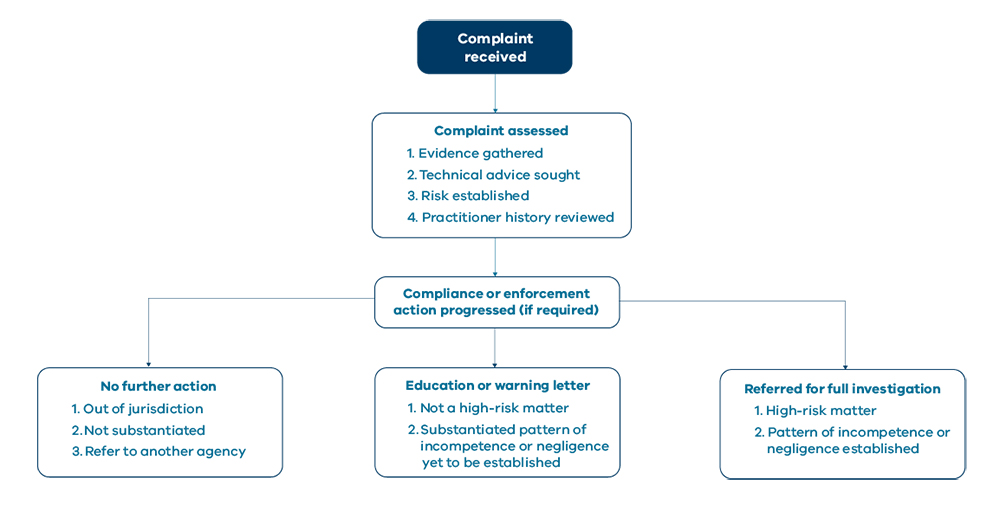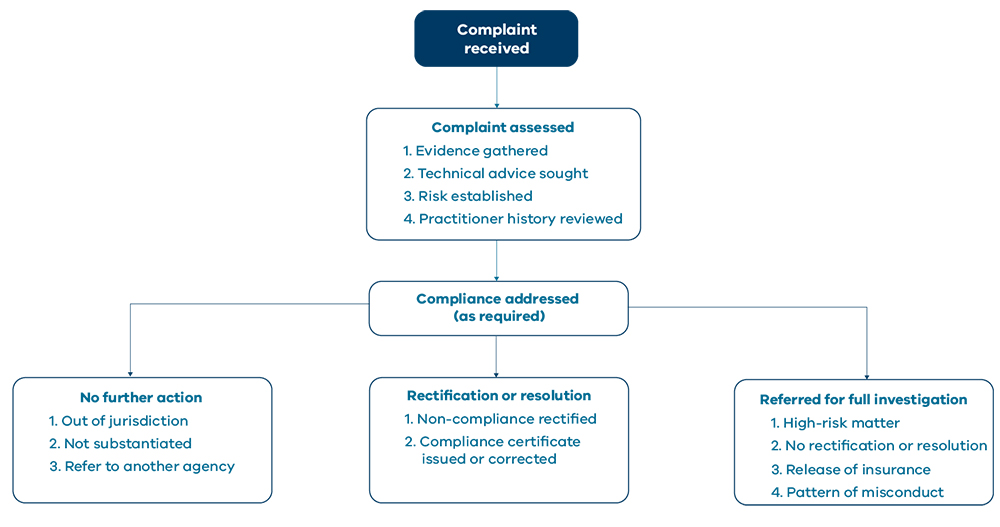VBA complaints process
The VBA may, if necessary, disclose your contact and other relevant personal information to external third parties when carrying out our complaint related functions. An example of this is when we refer a complaint to the Relevant Building Surveyor (RBS) for the site subject of a complaint for management and resolution.
You are not obligated to provide us with personal information with respect to your complaint, however if you choose not to do so we may be unable to provide a full range of services for you.
Further information about information privacy is available in the VBA Privacy Policy.
The VBA deals with complaints about problems with building or plumbing work in different ways. This is because different legislation applies. But in both cases, in the first instance you need to contact the relevant parties (such as building surveyor, builder, plumber, local council etc.) to discuss your concerns. This may help to resolve an issue, as you might get clarification or further advice on the matter.
If you do lodge a complaint with us, you need to attach written confirmation of any contact (or attempt to contact) the relevant parties, such as emails. If the relevant parties provided no response or no action was taken, you will need to confirm this. It is vital to provide evidence with your submission. This helps validate your claim/s and helps us make a fair assessment of the issue/s.
For both building and plumbing matters, you need to make your complaint through VBA360 – the VBA's online customer service portal.
To use VBA360, you need to register online and create an account. Once you have an account you can register as many complaints as required and track their progress. VBA360 allows you to upload evidence to support your complaint.
Find out more about the process for building and plumbing complaints below, and the possible outcomes of making a complaint.

Complaints services assesses the complaint
We will commence an initial review of a complaint we receive if:
- it involves a breach or offence of building legislation or regulations
- it involves the conduct of a registered practitioner
- it involves building work by an unregistered person
- the timeframes are within jurisdiction – generally this is within 10 years (however, building legislation also has a statute of limitations restricting when a prosecution can occur)
- if relevant, attempts have first been made to resolve concerns with the relevant building surveyor (RBS)
- there is enough information and evidence to support the complaint.
Please note: the VBA does not provide a property inspection service for people making a complaint.
On 1 January 2021, the Code of Conduct for Building Surveyors came into effect, requiring building surveyors to communicate promptly and effectively with their client, the VBA and relevant parties. It also requires building surveyors to provide a complaint handling process and address issues of non-compliance brought to their attention as soon as possible. You must attempt to resolve your concerns with the RBS before lodging a complaint with the VBA. If you have not already done so, the VBA will refer your concerns to the RBS in the first instance to address your concerns. If you have already attempted to resolve the matter with the RBS but have been unsuccessful, please ensure you provide evidence of your correspondence as per above for VBA assessment. You can normally find RBS contact details on the building work sign on the property where the works are being done.
If the complaint is more appropriate for another government agency, such as Domestic Building Dispute Resolution Victoria (DBDRV), you will be referred to that agency in the first instance. The matter may progress to the VBA at a later stage. A complaint about the conduct of a practitioner may be submitted for assessment once the DBDRV process has been finalised.
The VBA complaints process involves the following stages and outcomes:
- The relevant issues are identified, and all available evidence is gathered and assessed. Technical aspects are reviewed by a VBA Senior Technical Advisor where necessary.
- If non-compliant building work that needs to be brought into compliance is identified, we are likely to engage with the relevant building surveyor (RBS) and/or local council to ensure that the correct actions are taken.
- If breaches or offences of building legislation are identified, we will consider their severity and impact, the history of the practitioner, and the conduct of the practitioner in relation to the complaint. Possible outcomes are:
- educational letter (for low-severity matters, where there is no prior history)
- warning letter (for low severity matters where there is impact, but no relevant prior history)
- referral for investigation (for high severity matters, or where there is relevant history, or where the practitioner refuses to participate in addressing the complaint).
If there is any life safety issue that requires urgent attention, the complaint will be prioritised. This may include referral to the Municipal Building Surveyor or a site inspection by the VBA.
Official investigation and disciplinary action
We employ investigators and inspectors who are authorised to carry out official investigations. In conjunction with the VBA's compliance and enforcement policy, the Investigations Unit will carry out a risk assessment to determine the appropriate course of action.
The investigation may lead to a 'show cause process', which is the VBA's mechanism for holding currently registered building practitioners to account for their performance. The show cause process initiates disciplinary action, which may include
- a fine
- registration being suspended or cancelled
- acceptance of an enforceable undertaking, which is a legally binding agreement where the building practitioner agrees to do or not do something.
Breaches of the Building Act 1993 and other legislation by people other than registered practitioners can be dealt with by criminal prosecution or an official warning that is kept on record.
You can find out more about disciplinary action that applies to building practitioners in the Building industry section on Complaints and investigations.

Complaints services assesses the complaint
We assess complaints we receive from consumers and other agencies about plumbing work, with a view to resolving the complaint wherever possible.
These complaints may relate to:
- plumbing work that does not comply with relevant laws, regulations or Australian standards
- failure to lodge/issue a compliance certificate where it was required
- plumbing work carried out by people who are not registered or licensed to carry out that work.
You need to provide sufficient credible evidence to support your complaint, such as photographs or a plumbing report. The evidence is reviewed by a Senior Technical Advisor (Plumbing) who will determine what action is required.
Complaints about unregistered or unlicensed plumbing work must be lodged within three years of the work being carried out.
If a complaint is substantiated
We can take action on a substantiated complaint if the complaint relates to regulated plumbing work completed within 10 years of the complaint.
- If a complaint about non-compliant plumbing work appears substantiated, we expect the licensed plumber to return to the site and rectify the plumbing work, and provide evidence compliance has been achieved. Once we are satisfied with the rectification, the complaint is closed as resolved.
- If a compliance certificate was required but was not lodged/issued, we will expect the licensed plumber to lodge/issue the certificate to resolve the complaint. Likewise, if a compliance certificate needs to be corrected this is the action required for resolution. We may issue an infringement notice if a compliance certificate was not lodged/issued as required by legislation.
- If the plumber is no longer registered or you do not want the plumber to rectify the work and it is within the six-year warranty period, you will need to make a claim on the plumber’s insurance. To obtain the plumbers insurance details, you will need to make a freedom of information request.
A substantiated complaint may also result in the plumber having their future work audited for compliance.
Referral for investigation
If a complaint cannot be resolved as we are not satisfied compliance has been achieved, or a required compliance certificate has not been lodged/issued, the complaint will be referred to the Plumbing Investigations Unit.
All complaints about unlicensed or unregistered plumbing work are referred for investigation if there is sufficient credible evidence and the time frame will allow a prosecution to proceed.
If we identify a pattern of incompetence or negligence from numerous substantiated complaints against a licensed plumber, the plumber may be referred for an investigation.
Release of insurance
If the complaint was made within six years of the plumbing work and you do not want the original licensed plumber to return to the site, your complaint may be referred for investigation for release of insurance details. This will also occur if the plumber is no longer licensed or no longer available to rectify plumbing work.
Formal inquiry
If an investigation finds that a complaint is substantiated, the plumber may be referred for a formal inquiry. This involves a panel considering the evidence, and may result in:
- a reprimand
- a fine
- the plumber having to complete further training
- cancellation of the plumber's licence or registration for up to three years.
Make a complaint
If you are ready to lodge your complaint, visit VBA360 to register and access the online complaints form.
Once you have lodged your complaint, you will automatically receive an acknowledgement. The complaint will then be queued for allocation to an Assessment Officer. The timeframe for allocation will vary as it depends on the volume of complaints being experienced at the time. Once allocated and an initial assessment is completed, the Assessment Officer will contact you to discuss the matter in more detail.
You may be asked to provide more evidence depending on the nature of the complaint.
We are unable to give timeframes for how long a complaint will take to conclude, as this depends on the information that needs to be gathered and the complexity of the matter. Sources of information include the local council, the Relevant Building Surveyor (RBS), the subject(s) of the complaint and other parties. If expert technical advice is required, this may also contribute to the time it takes to reach a conclusion.
